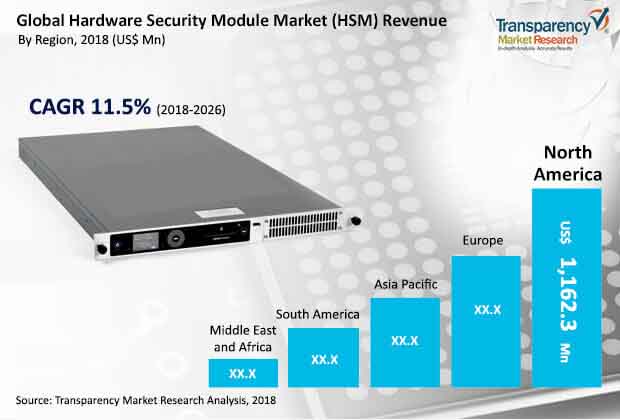Hardware Security Module (HSM) Market Sales and Revenue Share by CountriesPosted by Sakshi Mishra on February 4th, 2020 According to a new market report published by Transparency Market Research, the global hardware security module market is expected to reach a value of US$ 5,932.4 Mn by 2026 on account of rising security concerns across a number of industries. The market is projected to expand at a CAGR of 11.5% during the forecast period from 2018 to 2026.Growth of the hardware security module market is due to concerns over data breaches as well as increased spending on cyber security. Demand for HSM solutions is expected to surge in the coming years with more small and medium scale organizations involving in formulating encryption strategies.  Increased spending on cyber security driving the global hardware security module (HSM) market Spending on cyber security has increased over the years. Organizations are strategically allocating a significant share of their budget in deploying cyber security solutions. According to a study conducted by SANS Institute on ‘IT Security Spending Trends’ in February 2016, more than 50% of the total cyber security budget of organizations is spent on tools supporting access and authentication, followed by advanced malware and endpoint security, and data protection technologies. Looking for exclusive market insights from business experts? Request a Sample Report Hardware Security Module (HSM) Market: Scope of the Report The hardware security module (HSM) market is segmented based on type, application, and industry vertical. According to the research study, remote interface HSM held the significant share in 2016 in the global hardware security module market. However, smart cards and USB tokens are expected to show strong growth during the forecast period. This is largely due to the embedded features that these HSMs have. Since USB tokens and smart cards are lightweight, portable, and cost-efficient HSM types, they are heavily being deployed among medium and small enterprises around the world. Moreover, these HSMs do not require additional hardware, that makes them simple to install and operate, thereby making them popular among various organizations. The use cases of hardware security modules are plentiful, ranging from authentication to application level encryption. However, the most prominent application for which HSMs are largely being deployed is for authentication followed by Secure Sockets Layer (SSL) and document signing. Moreover, use of HSM devices for applications such as database encryption and credential management are expected to witness growth in the coming years. North America led the global hardware security module Smarket with a substantial share in 2016, primarily due to rising deployment of HSM devices for various applications across organizations operating in North America, particularly in the U.S. which hasgiven impetus to the HSM market.Furthermore, many new vendors are entering the HSM market in North America, thereby adding to the growth of HSM devices. Additionally, attempts made by developed economies to improve their security infrastructure and protect data from malicious attacks arealso supporting the growth in the North America region.The growth in the HSM market is also witnessing the formulation of stringent regulatory standards in North America and around the world, specifically for the vendors. The Federal Information Processing Standards (FIPS) (FIPS PUB 140-2) are the set of quality standards that approves cryptographic modules. FIPS 140-2 defines several levels of security, namely level 1, level 2, level 3, and level 4. The standard helps end-users to efficiently select the HSM device based on their requirement for data security. Like it? Share it!More by this author |


